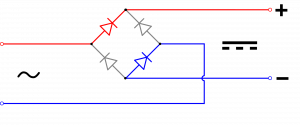List of Topics
- Rectification & Rectifier
- Types of Rectifier
- Bridge Rectifier
- Bridge Rectifier Circuit and Diagram
- Working of a bridge rectifier
- Differences between Bridge Rectifier and Full Wave Rectifier
- Mathematical problems
Rectification
Rectification: The process through which AC voltage is converted into Dc voltage is known as the rectification. Rectifier is the electronics device to perform the rectification
Types of Rectifiers
Rectifiers are mainly three types. They are –
- Half-Wave Rectifiers (HWR)
- Full-Wave Rectifiers (FWR)
- Bridge Rectifier (BR)
Bridge Rectifiers
Bridge rectifiers are kind of rectifiers that converts ac to dc that is alternating current to direct current. This type of rectifier allows both halves of the ac input voltage to pass through the circuit. Four diodes are necessary to make a bridge rectifier.
Bridge Rectifiers Working & Circuit
A bridge rectifier is shown in the below circuit.

Full-wave rectification can also be implemented with the help of a rectifiers, which includes four diodes. As shown in the circuit, two diodes of the opposite arms conduct current simultaneously while the other two diodes remained in OFF state. For Now, the current flows through the diode D1 and D3 but no current flows through the D2 and D4 diodes. This happens because of the instantaneous polarity of the secondary windings of the transformer. A current I thus pass through the load resistance RL in the shown direction.
Now, the next half of the cycle comes. This time the transformer’s polarity changes. Current flows through the Diode D2 and diode D4 and no current flows through the diodes D1 and D3. The direction of flow of current remains the same as the previous half of the cycle.
Know about How a Transformer works!
Bridge Rectifier Formula and Equations
From the standard Bridge rectifier circuit,
Vi is the input voltage; Vb is the diode voltage, rd is the dynamic resistance, R is the load resistance, Vo is the output voltage.
Average O/p voltage:
Vo = VmSinωt; 0 ≤ ωt ≤ π
Vav = 1/π * ∫02πVo d(ωt)
Or, Vav = 1/π * ∫02πVmSinωt d(ωt)
Or, Vav = (Vm/π) [- Cosωt]0π
Or, Vav = (Vm / π) * [-(-1) – (-(1))]
Or, Vav = (Vm/ π) * 2
Or, Vav = 2Vm / π = 0.64 Vm
The average load current (Iav) = 2* Im/π
The RMS (Root Means Square) Value of current:
Irms = [1/π * ∫ 0 2π I2 d(ωt)]1/2
I = ImSinωt; 0 ≤ ωt ≤ π
Or, Irms = [1/π * ∫ 0 2π Im2 Sin2ωt d(ωt)]1/2
Or, Irms = [Im2/π *∫ 0 2π Sin2ωt d(ωt)]1/2
Now, Sin2ωt = ½ (1 – Cos2ωt)
Or, Irms = [Im2/π *∫ 0 2π (1 – Cos2ωt)d(ωt)]1/2
Or, Irms = [Im2/2] ½ Or, Irms = Im/√2
The RMS voltage = Vrms = Vm/√2.
The significance of the RMS value is that it is equivalent to DC Value.
Provided that RMS value is ≤ Peak Value
Peak Inverse Voltage (PIV):
Peak inverse voltage or PIV is referred to as the maximum permissible voltage that can be applied to a diode before its breakdown.
Peak inverse voltage of a bridge rectifier is calculated as PIV >= Vm
Applying greater voltage than the peak inverse voltage will damage the diode and effect other circuit elements if associated.
Bridge Rectifier graph
The following graph shows the input output signal of a bridge rectifier. It is same as Bridge Rectifier.
Form Factor
The form factor of a bridge rectifier is the same as a full-wave rectifier and is defined as the ratio of RMS (Root Means Square) Value of load voltage to the average value load Voltage.
Form Factor = Vrms / Vav
Vrms = Vm/2
Vav = Vm / π
Form Factor = (Vm/√2) / (2*Vm/ π) = π/2√2=1.11
So, we can write, Vrms = 1.11 * Vav.
Ripple Factor
Ripple factor of a bridge rectifier is the percentage of Alternating Current component present in the output of the bridge rectifier.
The ‘γ’ represents the ripple factor.
Io = Iac + Idc
Or, Iac = Io – Idc
Or, Iac = [1/(2π) * ∫02π(I-Idc)2d(ωt)]1/2
Or, Iac = [Irms2 + Idc2– 2 Idc2]1/2
Or, Iac = [Irms2 – Idc2]1/2
So, Ripple factor,
γ = Irms2 – Idc2 / Idc2
or, γ = [(Irms2 – Idc2) – 1] 1/2
γFWR = 0.482
Transformer Utilization Factor
The ratio of DC power to the rated AC power is known as the Transformer utilization factor or TUF.
TUF = Pdc/ Pac(rated)
Vs / √2 is the voltage rated for the secondary winding and Im/2 is the current flowing through the winding.
So, TUF = Idc2 RL / (Vs/ √2) * (Im / √2)
TUF = (2Im/ π)2RL / ( Im2 (Rf +RL)/(2√2) = 2√2/ π 2 * (1 / (1 + Rf/RL))
If Rf << RL, then,
TUF = 8 / π 2 = 0.812
The more the TUF, the better the performance.
Bridge Rectifier Efficiency
Efficiency of bridge rectifier is defined as the ratio of the DC power supplied at the load to the input AC power. It is represented by the symbol – η
η = Pload / Pin *100
or, η = Idc2 * R/ Irms2 * R , as P = VI, & V= IR
Now, Irms = Im/√2 and Idc = 2*Im/π
So, η = (4Im2/ π2) / (Im2/2)
η = 8 / π2 * 100% = 81.2%
Efficiency of an ideal Bridge Rectifier Circuit is = 81.2%
Specify Difference Between Bridge and Full Wave Rectifier
| Subject of Comparison | Bridge Rectifier | Full Wave Rectifier |
| No. of diodes used | Four diodes are used | Two diodes are used |
| Current flow | Current flows in the circuit for only the positive half of the input cycle. | Current flows in the circuit for all half of the input cycle. |
| Transformer Required | Any small step-down or step-up transformer | Centre Tapped transformers are the centre required for full-wave rectifiers. It also needs a more oversized transformer than a bridge rectifier. |
| Peak Inverse Voltage | For a bridge rectifier, peak inverse voltage is the maximum voltage across the transformer’s secondary winding. | For the full-wave rectifier, each diode’s peak inverse voltage is twice the maximum voltage between the center tap and any other end of the transformer’s secondary winding. |
| Availability | A bridge wave rectifier is available in the market in one package. | Ready-made full-wave rectifiers are not available in the market. |
| Cost | Cheaper than full-wave rectifiers. | Costlier than bridge rectifier. |
| Transformer Utilization Factors | Transformer Utilization Factor is 0.812 | For a full-wave transformer, TUF is = 0.693 |
| Efficiency for low voltages | Current flows through two diodes in series in a bridge rectifier, and immense power dissipates in the diodes. Hence efficiency is lower in low voltage conditions. | There is no such effect on full-wave rectifiers. Efficiency is more in such a condition than a bridge rectifier. |
Some Problems with Bridge Rectifiers
1. A bridge rectifier has a load of 1 kilo- ohm. The applied AC voltage is 220 V (RMS value). If the diodes’ internal resistances are neglected, what will be ripple voltage across the load resistance?
a. 0.542 V
b. 0.585 V
c. 0.919 V
d. 0.945 V
The ripple voltage is = γ * Vdc / 100
Vdc = 0.636 * Vrms * √2 = 0.636*220*√2 = 198 V.
The ripple factor of an ideal full-wave rectifier is 0.482
Hence the ripple voltage = 0.482*198/100 = 0.945 V
2. If the peak voltage of a bridge rectifier circuit is 10 V and the diode is silicon diode, what will be the peak inverse voltage on the diode?
Peak inverse voltage is an important parameter defined as the maximum reverse bias voltage applied across the diode before entering the breakdown region. If the peak inverse voltage rating is less than the value, then breakdown may occur. For a full-wave rectifier, the diode’s peak inverse voltage is the same as the peak voltage = Vm. So, peak inverse voltage =5 volts.
3. A input of 100Sin 100 πt volt is applied to a full-wave rectifier. What is the output ripple frequency?
V= VmSinωt
Here, ω= 100
Frequency is given as – ω/2 = 100/2 = 50 Hz.
Thus, the output frequency = 50*2 = 100 Hz.
4. What is the main application of a rectifier? Which device does the opposite operation?
A rectifier transforms the AC voltage to the DC voltage. An oscillator converts a DC voltage to AC voltage.
5. For a bridge rectifier, the input voltage applied is 20Sin100 π t. What will be the average output voltage?
Now we know that, V= VmSinωt
Vm = 20
So, the output voltage = 2Vm / π = 2*20 / π = 12.73 volts
The output voltage is = 12.73 volts.

Hi, I am Sudipta Roy. I have done B. Tech in Electronics. I am an electronics enthusiast and am currently devoted to the field of Electronics and Communications. I have a keen interest in exploring modern technologies such as AI & Machine Learning. My writings are devoted to providing accurate and updated data to all learners. Helping someone in gaining knowledge gives me immense pleasure.
Let’s connect through LinkedIn –